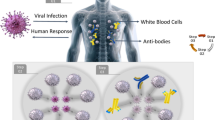Abstract
This study first considers the effects of “uninfectious” HIV-1 due to fatal mutations, and then analysis reveals that AIDS develops when the number of HIV-1 strains, i.e., antigenic diversity, is above a “time-dependent” threshold. This result is interesting because it suggests the possibility that the onset of AIDS could be dynamically determined. This dynamic behavior of the threshold may make the prediction of AIDS development difficult.
Similar content being viewed by others
Explore related subjects
Discover the latest articles and news from researchers in related subjects, suggested using machine learning.References
Green WC, Peterlin BM (2008) Molecular biology of HIV: implications for new therapies. In: Volberding PA, Sande MA, Warner C, et al (eds) Global HIV/AIDS medicine. Elsevier, Pennsylvania, pp 23–38
Preston BD, Poiesz BJ, Loeb LA (1988) Fidelity of HIV-1 reverse transcriptase. Science 242(4882):1168–1171
de Mercoyrol L, Job C, Job D (1989) Studies on the inhibition by alpha-amanitin of single-step addition reactions and productive RNA synthesis catalysed by wheat-germ RNA polymerase II. Biochem J 258(1):165–169
Domingo E (2000) Viruses at the edge of adaptation. Virology 270:251–253
Holland JJ, Domingo E (1998) Origin and evolution of viruses. Virus genes 16:13–21
Nowak MA, May RM (1991) Mathematical biology of HIV infections: antigenic variation and diversity threshold. Math Biosci 106:1–21
Nowak MA, May RM (2000) Virus dynamics. Oxford University Press, Oxford
Author information
Authors and Affiliations
Corresponding author
Additional information
This work was presented in part at the 14th International Symposium on Artificial Life and Robotics, Oita, Japan, February 5–7, 2009
About this article
Cite this article
Harada, K., Ishida, Y. A time-dependent threshold condition to determine the onset of AIDS. Artif Life Robotics 14, 532–534 (2009). https://doi.org/10.1007/s10015-009-0737-3
Received:
Accepted:
Published:
Issue Date:
DOI: https://doi.org/10.1007/s10015-009-0737-3




